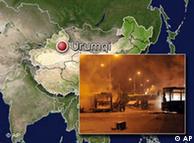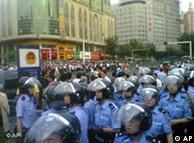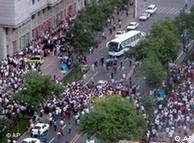| 时事风云 | ||
| 世界维吾尔大会回应北京指责 | ||||
 | 上周日新疆乌鲁木齐发生大规模骚乱事件。 [更多] | |||
| 德国对新疆骚乱作出反应 | ||||
 | 中国新疆乌鲁木齐周日发生严重骚乱,导致至少140人死亡。 [更 | |||
WSJ 的中國簡訊
July 6, 2009, 7:35 AM ET
China Journal Wrap: Xinjiang Riots, Domestic Firms Invest in Dairy
• At least 140 people are dead and hundreds more were injured in violent protests in the northwest Chinese city of Urumqi, the capital of China’s predominantly Muslim Xinjiang autonomous region.
紐約時報
China Locks Down Restive Region After Deadly Clashes

Chinese soldiers patrolling the streets of Urumqi Monday. More Photos >
URUMQI, China — The Chinese government locked down this regional capital of 2.3 million people and other cities across its western desert region on Monday and early Tuesday, imposing curfews, cutting off cellphone and Internet services and sending armed police officers into neighborhoods after clashes erupted here on Sunday evening between Muslim Uighurs and Han Chinese. The fighting left at least 156 people dead and 852 injured, according to the state news agency.
Multimedia
Readers' Comments
Readers shared their thoughts on this article.
It was the deadliest incident of ethnic violence in China in decades. The bloodshed here, along with the Tibetan uprising last year, shows the extent of racial hostility that still pervades much of western China, fueled partly by government attempts to restrict religious and political activity by minority groups.
The riot, which began as a peaceful protest calling for a full government inquiry into an earlier brawl between Uighurs and Han Chinese at a factory in southern China, took place in the heart of Xinjiang, an oil-rich desert region where Uighurs are the largest ethnic group but are ruled by the Han.
Protests spread on Monday to the heavily guarded oasis town of Kashgar, on China’s remote western border, as 200 to 300 people chanting “God is great” and “Release the people” confronted riot police officers at about 5:30 p.m. in front of that city’s yellow-walled Id Kah Mosque, the largest in China. They quickly dispersed when officers began arresting people, said one resident.
Internet social platforms and chat programs appeared to have unified Uighurs in anger over the way Chinese officials had handled the earlier brawl, which took place in late June thousands of miles away in Shaoguan, Guangdong Province. There, Han workers rampaged through a Uighur dormitory, killing at least two Uighurs and injuring many others, according to Xinhua. The police later arrested a resentful former factory worker who had ignited the brawl by spreading a rumor that six Uighur men had raped two Han women at the site, the official Xinhua new agency reported.
But photographs that appeared on the Internet after the battle showed people standing around a pile of corpses, leading many Uighurs to believe that the government was downplaying the number of Uighur deaths. One Uighur student said the photographs began showing up on many Web sites about one week ago. Government censors kept trying to delete them, but to no avail, he said.
“Uighurs posted it again and again in order to let more people know the truth, because how painful is it that the government does bald-faced injustice to Uighur people?” said the student, who did not want his name published for fear of government retribution.
A call for protests spread via Web sites and QQ, the most popular instant-messaging program in China, despite government efforts to block online discussion of the incident.
By Monday evening, the police had detained 700 suspects, according to Xinhua. More than 200 shops and 14 homes had been destroyed in Urumqi, and 261 motor vehicles, mostly buses, had been burned, Xinhua reported, citing Liu Yaohua, the regional police chief.
Police officers operated checkpoints on roads leading in and out of Urumqi on Monday. The major hotels said they had no Internet access. Most people in the city could not use their cell phones.
At the airport, five scrawny young men wearing black bulletproof vests and helmets stood outside the terminal, batons in hand. The roadways leading into the city center were empty early Tuesday, except for parked squad cars and clusters of armored personnel carriers and olive military trucks brimming with paramilitary troops. An all-night curfew had been imposed.
Residents described the central bazaar in the Uighur enclave, where much of the rioting took place, as littered with the charred hulks of buses and cars.
An American teacher in Urumqi, Adam Grode, and one other foreigner said they heard gunfire long after nightfall on Sunday.
Xinhua did not provide a breakdown of the 156 deaths, and it remained unclear how many of the dead were protestors and how many were other civilians or police officers. There were no independent estimates of the number of the death toll. At least 1,000 people were described as having taken part in the unrest.
Photographs on the Internet and footage on state television showed people lying injured in the streets, not far from overturned cars or vehicles that had been set ablaze. Government officials handed journalists in Urumqi a CD with a video showing bodies strewn in ones or twos in the streets, many with faces and heads smeared in blood.
The officials also released a statement that laid the blame directly on Rebiya Kadeer, a Uighur businesswoman and human rights advocate who had been imprisoned in China and now lives in Washington. It said the World Uyghur Congress, a group led by “the splittist” Ms. Kadeer, “directly ignited, plotted and directed the violence using the Shaoguan incident in Guangdong.” The statement said bloggers first began calling for the protest on Saturday night, and used QQ, bulletin boards and blogs to organize a rally at People’s Square and South Gate in the Uighur quarter of Urumqi. The World Uyghur Congress rejected the accusations and said that it condemned “in the strongest possible terms the brutal crackdown of a peaceful protest of young Uyghurs.” The group said in a statement Monday that Uighurs had been subject to reprisals not only from Chinese security forces but also from Han Chinese civilians who attacked homes, workplaces or dormitories after the riots on Monday.
The violence on Sunday dwarfed in scale a series of assaults on security forces last year in Xinjiang. It was deadlier, too, than any of the bombings, riots and protests that swept through the region in the 1990s and that led to a severe government clampdown.
Uighurs make up about half of the 20 million people in Xinjiang, but are a minority in Urumqi, where Han Chinese dominate. The Chinese government has encouraged Han migration to many parts of Xinjiang, and Uighurs say Han tend to get the best jobs in the city. The government also maintains tight control on the practice of Islam, which many Uighurs cite as a source of frustration.
But an ethnic Han woman who lives in an apartment near the central bazaar said in a telephone interview that the government should show no sympathy toward the malcontents.
“What they should do is crack down with a lot of force at first, so the situation doesn’t get worse, so it doesn’t drag out like in Tibet,” she said after insisting that her name not be used. “Their mind is very simple. If you crack down on one, you’ll scare all of them. The government should come down harder.”
ENDIT
• Chinese dairy giant Mengniu is selling a 20% stake for around $780 million to Cofco, a state-owned food company, and Hopu Investment Management Co., a domestic private equity firm.
• Three Shanghai companies formally ushered in a new era for the yuan by using the Chinese currency to conduct cross-border trades for the first time.
• Ford (F) said Monday its sales in China for the first half of 2009 were up 14% from a year earlier, while Audi reported an 11% increase in its China sales during the same period.
• China’s sovereign wealth fund has appointed an international advisory board of 14 experts to provide guidance on its overseas investments. The board met on Sunday, two days after China Investment Corp. announced a $1.5 billion investment in a Canadian mining company, its first foray into natural resources.
• David Dollar, who was until recently the World Bank’s China country director, reflects on his key takeaways about China’s development after five years on the job. Dollar will remain in China in a new post as the U.S. Treasury Department’s economic emissary.
• By 2050, a third of China’s population will be over the age of 60, representing a major demographic shift that will stress government resources and long-term economic growth.
• Six officials have reportedly been punished for their involvement in sending babies whose parents were alive to an orphanage in southern China that subsequently placed the children up for adoption overseas.
• Massive flooding in southern and central China has forced the evacuation of more than 320,000 people from their homes.
–Sky Canaves



沒有留言:
張貼留言